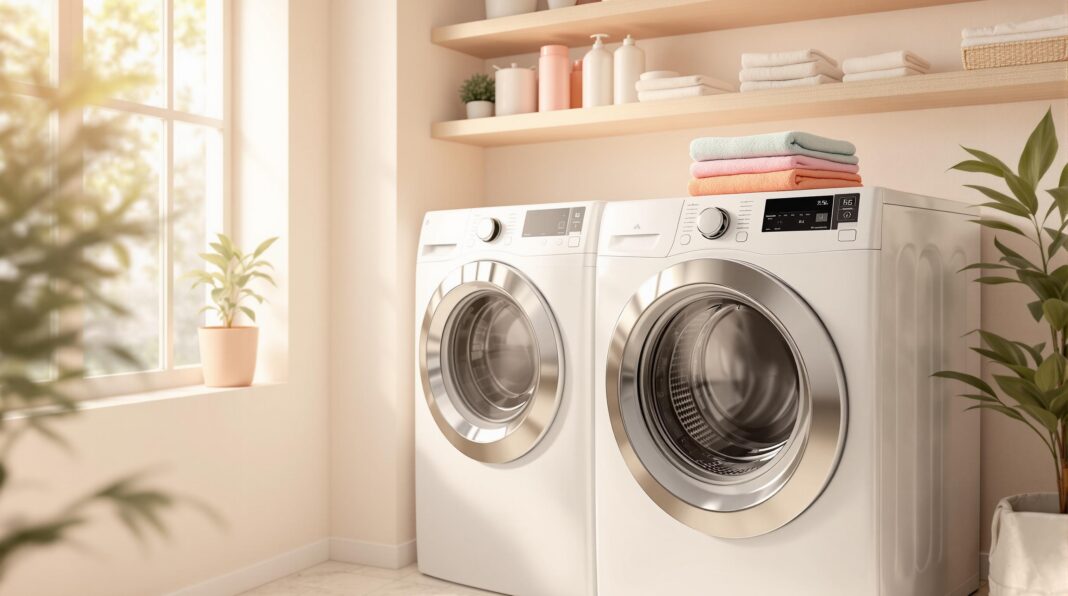Want your washer and dryer to last longer and work better? Regular maintenance is the key. Here’s a quick summary of what you can do:
- Level your machines: Prevent wobbling to avoid damage.
- Clean regularly: Use vinegar for the washer drum, wipe the dryer drum, and clean detergent drawers and gaskets monthly.
- Avoid overloading: Stick to load size limits to prevent extra strain.
- Use the right detergent: Choose HE detergents for HE washers and specific detergents for delicates or heavy soils.
- Inspect water hoses: Check for cracks or leaks every few months and replace them every 3–5 years.
- Empty the lint trap: Clean it after every dryer load to ensure airflow and safety.
- Leave washer doors open: Air out to prevent mold and odors.
- Clear dryer vents: Remove blockages to reduce fire risks and improve efficiency.
- Balance heavy items: Distribute weight evenly in the drum.
- Schedule professional checks: Annual inspections catch hidden issues early.
Quick Tip: Small, consistent efforts like these can save you money on repairs and keep your appliances running smoothly for years.
Washing Machine and Dryer Maintenance Tips
1. Check and Adjust Machine Level
If your washer or dryer isn’t sitting level, the drum can wobble, putting strain on the bearings and motor mounts. Make sure your appliance is on a flat surface and adjust the leveling feet as needed to keep it steady.
2. Remove Dirt and Residue
Keeping your washer and dryer clean is key to avoiding buildup and ensuring they work efficiently for longer. Regular maintenance can help prevent wear and tear while keeping your machines running smoothly.
For your washer, start by running an empty hot water cycle with 2 cups of white vinegar to break down mineral deposits and soap scum. If you have a front-loading washer, don’t forget to clean the rubber door gasket. Use a mixture of equal parts water and vinegar to wipe it down, which helps keep mold and mildew at bay.
Next, address detergent and residue buildup. Take out any removable detergent drawers at least once a month. Soak them in warm water with a mild cleaner, and use a toothbrush to scrub away any grime stuck in the corners.
Now, turn your attention to the dryer. Wipe the dryer drum every month with a damp cloth and a bit of mild soap. This helps clear away any buildup from fabric softeners or dryer sheets.
| Area to Clean | Cleaning Method | Frequency |
|---|---|---|
| Washer Drum | Hot water cycle with vinegar | Monthly |
| Door Gasket | Vinegar-water solution | Monthly |
| Detergent Drawer | Soak in warm water and scrub | Monthly |
| Dryer Drum | Damp cloth with mild soap | Monthly |
Important: Never mix cleaning products, especially bleach and vinegar, as this can release harmful fumes. Always clean in a well-ventilated area.
Once you’ve finished cleaning, run an extra rinse cycle in the washer to remove any leftover cleaning solution. For the dryer, make sure the drum is completely dry before using it again to avoid transferring any residue to your clothes.
3. Follow Load Size Limits
Overloading your washer and dryer can wear out their internal parts faster than normal. It puts extra strain on key components like motors, belts, and bearings, which shortens the lifespan of your appliances. Here’s how to avoid that with some simple tips.
For washers, don’t pack the drum too tightly. Leaving enough space allows water to circulate properly, which is crucial for effective cleaning. Check your washer’s manual for specific load size recommendations for your model.
For dryers, filling the drum about 75% full is a good rule of thumb. This ensures proper tumbling and airflow, which helps reduce stress on the motor and heating element.
If you notice wet clothes, unusual noises, excessive vibration, incomplete cleaning, or longer drying times, these could be signs that you’re overloading your machines.
For front-loading washers, pay extra attention to weight distribution. Washing heavy or bulky items like comforters on their own can prevent unbalanced loads that may damage the drum suspension system. Always compare your load size to the capacity listed in your manual, and if your washer has a “bulky item” or “heavy load” setting, use it to minimize wear and tear.
Keeping your loads within the recommended limits not only helps your washer and dryer last longer but also ensures they run more efficiently, saving energy and reducing unnecessary stress on the machines.
4. Pick the Correct Detergent Type
Using the right detergent can improve cleaning results and help your washer last longer. If you have an HE (High-Efficiency) washer, make sure to use detergents specifically labeled for HE machines. These are designed to create fewer suds, which is crucial for proper cleaning in these washers.
For delicate fabrics like wool or silk, opt for detergents formulated for gentle care. On the other hand, if you’re dealing with heavily soiled items, go for a heavy-duty detergent to tackle tough stains effectively.
Here’s a quick guide to help you choose the right detergent:
| Load Type | Recommended Detergent | Key Benefits |
|---|---|---|
| Regular Loads | HE Standard Detergent | Cleans effectively with low suds |
| Delicates | Gentle/Wool-Specific HE | Protects and cleans delicate fabrics |
| Heavy Soils | Heavy-Duty HE Detergent | Stronger stain-removal capabilities |
Following these tips can keep your washer in great shape and ensure your laundry comes out clean. Always refer to your washer’s manual for specific detergent recommendations.
Looking for more home care tips? Check out Home Base Project (https://homebaseproject.org) for practical advice and DIY ideas to keep your household running smoothly.
5. Monitor and Replace Water Hoses
Water hoses play a crucial role in your washing machine’s operation, and regular checks can help prevent costly water damage while keeping your appliance running smoothly. Inspect these hoses every 3–4 months to spot potential problems early.
Here’s what to look for when inspecting your water hoses:
- Cracks or bulges: Signs of material weakening.
- Moisture or leaks: Especially around connection points.
- Rust or discoloration: Check metal fittings for signs of corrosion.
- Kinks or bends: These can restrict water flow and lead to damage.
Even if everything looks fine, it’s a good idea to replace your hoses every 3–5 years as a precaution. When replacing, opt for reinforced rubber hoses or stainless-steel braided hoses, as they are far more durable than standard rubber hoses.
Hose Replacement Overview
| Hose Type | Lifespan | Average Cost | Benefits |
|---|---|---|---|
| Standard Rubber | 3–5 years | $10–$20/pair | Basic option, low cost |
| Reinforced Rubber | 5–8 years | $20–$30/pair | More durable, burst-resistant |
| Stainless-Steel Braided | 8–10 years | $30–$50/pair | Best durability, heat-resistant |
Steps for Installing New Hoses
- Turn off the water supply and place rubber washers at the connections.
- Hand-tighten the connections to avoid over-tightening.
- Use pliers to give each fitting a quarter turn for a secure fit.
- Restore water supply and check carefully for any leaks.
Make sure to leave at least 4 inches of space behind the washer to prevent the hoses from kinking. Regular maintenance like this can save you from unexpected headaches down the road.
sbb-itb-2235312
6. Empty the Lint Trap After Each Use
Clearing your dryer’s lint trap after every load is a simple yet crucial step. It keeps airflow steady, reduces the risk of fires, and helps your dryer use less energy.
Here’s how to keep your dryer working efficiently:
- Clean the lint trap after every load to prevent buildup.
- Wash the lint filter occasionally with warm, soapy water to remove any residue.
- Check the lint filter regularly for damage, and replace it if necessary.
These small steps can make a big difference in your dryer’s performance and safety.
7. Keep Washer Door Open Between Loads
Leaving your washer door open between cycles helps prevent moisture buildup, especially in front-load washers. The rubber gasket in front-loaders tends to trap moisture, which can lead to mold, mildew, and unpleasant odors that affect the machine’s performance.
Even though top-load washers are less prone to retaining moisture due to their open design, keeping the lid open can still help avoid any potential odor issues.
For more maintenance tips, check out Home Base Project.
8. Clear Dryer Vent Blockages
A clogged dryer vent can be a serious fire risk. It also makes your dryer work harder, leading to more wear and tear and longer drying times.
Notice your clothes taking longer to dry or a burning smell? These are signs your vent might be blocked. Here’s how to fix it:
- Check the outdoor vent cover: Clear any lint or debris, and make sure the vent flap opens and closes smoothly.
- Inspect the vent duct: Look for blockages or any signs of damage that might restrict airflow.
- Clean out lint buildup: Use a vent brush or a vacuum to remove lint from inside the vent.
Keeping your dryer vent clear not only ensures it runs efficiently but also reduces the risk of fire. For more tips on maintaining appliances and improving home safety, check out Home Base Project’s appliance care guides.
9. Balance Heavy Laundry Items
Keeping your laundry load balanced is just as important as sticking to the size limits. An unbalanced load – especially with heavy items – can put extra stress on your washer’s motor, bearings, and suspension rods. This can lead to annoying vibrations, potential damage, and expensive repairs.
Here’s how to spot an unbalanced load:
- Loud thumping or banging sounds
- Excessive shaking during the spin cycle
- The washer shifting or “walking” across the floor
- Clothes coming out too wet after spinning
To avoid these issues and keep your washer running smoothly, try these tips:
- Spread heavy items evenly around the drum to distribute the weight.
- Mix in lighter items to help maintain balance during the spin cycle.
These simple steps can help protect your washer and keep it working longer.
10. Get Regular Service Checks
While regular DIY maintenance is helpful, professional service plays a key role in keeping your washer and dryer in top shape. Experts can spot problems that might go unnoticed during routine care. Aim for an annual inspection to review belts, hoses, electrical connections, and internal parts. A thorough deep cleaning, including lubrication, every few years can also help.
Here’s what a technician typically handles:
- Check water sensors and thermostats to ensure proper functioning.
- Inspect door seals and gaskets for signs of wear or leaks.
- Examine belt tension and alignment to avoid unnecessary strain.
- Verify electrical connections for safety and efficiency.
- Evaluate drum bearings and supports to prevent mechanical issues.
Be sure to contact a professional if you notice any of the following:
- Strange noises like grinding, squealing, or thumping.
- Issues with performance, such as poor cleaning or longer drying times.
- Water-related problems, including leaks, poor drainage, or irregular levels.
- A burning smell from the dryer.
- Error messages or controls that don’t respond.
Taking these steps can prevent small problems from becoming costly repairs.
Conclusion
Taking care of your washers and dryers isn’t just about avoiding breakdowns – it’s about protecting your investment and keeping them running efficiently. By sticking to these ten tips, you can extend their lifespan and steer clear of costly repairs.
Regular tasks like leveling, cleaning, and smart loading habits go a long way in reducing wear and tear. Combine these with occasional professional check-ups, and you’ve got a simple yet effective routine to keep your appliances in top shape.
Looking for more DIY tips and appliance advice? Check out Home Base Project. They offer detailed maintenance guides and practical solutions to help you get the most out of your laundry appliances.


